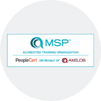
Advance your career with our CBAP Training Program, designed to provide comprehensive knowledge in business analysis. Cover key areas such as advanced elicitation, modeling techniques, and solution evaluation. This course offers hands-on practice and theoretical knowledge needed to pass the CBAP certification exam. Ideal for experienced analysts aiming to refine their strategic insights and assert their expertise in improving business processes and project success.
CBAP Interview Questions Answers - For Intermediate
1. How do you ensure that delivered solutions meet business requirements?
Solutions are validated against requirements through user acceptance testing (UAT) where stakeholders verify the solution in real conditions before going live.
2. What is the BABOK Guide?
The BABOK Guide is the collection of knowledge within the profession of Business Analysis and reflects the work of thousands of practitioners.
3. What role does a business analyst play in the Agile process?
In Agile, a business analyst helps define user stories, refine product backlogs, and ensure that the agile team understands the business context.
4. Explain the importance of user stories.
User stories help capture a specific functionality from an end-user perspective, aiding in delivering value through well-defined requirements.
5. What is the difference between business analysis and business analytics?
Business analysis focuses on identifying business needs and solutions, whereas business analytics involves analyzing data to find trends and make predictions.
6. How do you validate requirements?
Requirements validation ensures requirements meet business needs and are achievable. Techniques include reviews, prototyping, and test case development.
7. What are some common business analysis performance metrics?
Common metrics include time to market, requirement volatility, stakeholder satisfaction, and the number of requirements changes.
8. Describe an instance where you resolved a conflict within your team.
A conflict was resolved by facilitating a meeting to address misunderstandings between team members over project priorities, leading to an agreement on clear roles and responsibilities.
9. What is the difference between a functional requirement and a business requirement?
Functional requirements specify actions a system must perform, while business requirements are high-level statements of what the organization aims to achieve.
10. How do you handle a situation where a stakeholder consistently changes requirements?
Constant requirement changes are managed by educating the stakeholders on the impact of changes and setting clear boundaries for when changes are acceptable.
11. What techniques are used for risk management?
Techniques include risk identification, assessment, mitigation planning, and monitoring.
12. Explain the role of a business analyst during testing.
A business analyst verifies that the testing covers all requirements, reviews test plans, and assists in troubleshooting any discrepancies in test results.
13. What is a business process model?
A business process model outlines the steps of a business process, from start to finish, typically through a visual diagram.
14. How do you manage documentation across the lifecycle of a project?
Documentation is managed by using document management systems, adhering to standards for document storage, access, and revision control.
15. What are the challenges in aligning IT and business strategies?
Challenges include differing objectives, communication gaps, and resistance to change. Alignment can be facilitated by clearly defined roles, shared objectives, and continuous dialogue.
CBAP Interview Questions Answers - For Advanced
1. Explain how business analysts use financial analysis techniques in project evaluation.
Business analysts use financial analysis techniques like NPV (Net Present Value), IRR (Internal Rate of Return), and payback period to evaluate the financial viability of projects. These techniques help in assessing the expected financial benefits against the costs and determining the project's potential to deliver financial value. Such analysis is crucial for making informed investment decisions and prioritizing projects based on their financial impact.
2. What methodologies can be used to handle risks in business analysis?
Methodologies such as risk assessment matrices, which prioritize risks based on their likelihood and impact, and SWOT analysis, which identifies internal and external risks, are used. Implementing risk mitigation strategies like contingency planning, risk transfer, or avoidance, and continuous monitoring are essential practices to manage risks effectively.
3. Describe the integration of business intelligence tools in business analysis.
Business intelligence tools are integrated into business analysis to provide data-driven insights that support decision-making. These tools help in aggregating, analyzing, and visualizing large volumes of data to identify patterns, trends, and insights that are critical for strategic planning. Business analysts use these tools to deliver comprehensive reports that inform business strategies and improve operational efficiencies.
4. What are the best practices for documenting business requirements?
Best practices for documenting business requirements include using clear, concise, and unambiguous language, ensuring that requirements are measurable and testable, and organizing them logically. Documenting assumptions and constraints is also crucial. Using standardized templates and tools for consistency and employing version control to track changes are recommended to maintain document integrity throughout the project.
5. How do business analysts facilitate the implementation of technology solutions?
Business analysts facilitate the implementation of technology solutions by ensuring that the technical solutions align with business requirements and objectives. They support the configuration, customization, and integration of technology solutions, oversee the testing phases to ensure that the solution meets the defined requirements, and coordinate training and support for end-users to ensure smooth adoption and functionality.
6. Discuss the role of a business analyst in quality assurance.
In quality assurance, a business analyst ensures that the outputs of a project meet the required standards and are free from defects. They are involved in developing test strategies, reviewing test plans, and participating in testing to verify that the solutions meet business requirements. Their deep understanding of the business processes and requirements helps in identifying any discrepancies during the QA phase and ensuring that the end product is of high quality.
7. Explain the use of KPIs in monitoring project performance.
KPIs (Key Performance Indicators) are used to quantitatively measure the performance of a project against its expected outcomes. Business analysts define relevant KPIs based on the project's objectives and monitor these indicators throughout the project lifecycle to assess performance, make informed decisions, and guide strategic adjustments. KPIs help in identifying trends, predicting outcomes, and measuring the success of project initiatives.
8. How do you manage the requirements lifecycle?
Managing the requirements lifecycle involves activities such as elicitation, documentation, analysis, validation, and management of changes. It requires maintaining a traceable audit trail for requirements to ensure that all changes are documented and approved. Using requirements management tools can aid in tracking the requirements across their lifecycle, ensuring they are met during project delivery and are aligned with the business objectives.
9. What are the ethical considerations for a business analyst?
Ethical considerations for a business analyst include maintaining confidentiality, avoiding conflicts of interest, ensuring transparency in reporting, and dealing fairly with all stakeholders. Ethical behavior also involves adhering to professional standards and guidelines as defined by the IIBA (International Institute of Business Analysis) and ensuring that their actions contribute positively to the organization.
10. Discuss the significance of business process reengineering.
Business process reengineering involves the radical redesign of core business processes to achieve significant improvements in productivity, efficiency, and quality. It is significant because it helps organizations rethink how work is done to dramatically improve customer service, cut operational costs, and become world-class competitors. A business analyst plays a key role in mapping existing processes, identifying inefficiencies, and designing new processes that align with business goals.
11. How do you ensure stakeholder engagement throughout the project?
Ensuring stakeholder engagement involves identifying all stakeholders early in the project, understanding their interests and influence levels, and developing a communication plan that addresses their needs and preferences. Regular updates, feedback sessions, and involving stakeholders in decision-making processes help maintain their interest and engagement throughout the project.
12. What are the challenges of working with cross-functional teams, and how are they addressed?
Working with cross-functional teams presents challenges such as conflicting priorities, varying work cultures, and misalignment of goals. These are addressed by establishing clear project objectives, creating a shared vision, and fostering an inclusive culture that values each team member's contribution. Effective communication strategies and conflict resolution mechanisms are also vital to manage and harmonize cross-functional team dynamics.
13. Describe techniques for effective conflict resolution in project management.
Techniques for effective conflict resolution include active listening to understand different perspectives, facilitating open and honest communication, and identifying the underlying causes of conflict. Employing negotiation skills to find a compromise, seeking mediation from higher management when necessary, and defining clear roles and responsibilities can also help in resolving conflicts effectively.
14. How can business analysts drive innovation within organizations?
Business analysts can drive innovation by identifying and analyzing emerging trends and technologies that can impact the business. They play a key role in brainstorming sessions to generate innovative ideas and can pilot new processes or technologies on a small scale before a full rollout. By fostering an environment that encourages experimentation and learning, they help organizations adapt to changes and foster a culture of innovation.
15. Discuss the importance of continuous learning for a business analyst.
Continuous learning is crucial for a business analyst to stay updated with the latest industry trends, methodologies, and technologies. It enables them to provide the best possible solutions and maintain their relevance in a rapidly changing business environment. Engaging in professional development opportunities, attending workshops, and obtaining certifications are ways business analysts can continue to enhance their skills and contribute effectively to their organizations.
Course Schedule
| Dec, 2025 | Weekdays | Mon-Fri | Enquire Now |
| Weekend | Sat-Sun | Enquire Now | |
| Jan, 2026 | Weekdays | Mon-Fri | Enquire Now |
| Weekend | Sat-Sun | Enquire Now |
Related Courses
Related Articles
Related Interview
- SP3D-Electrical, Smart Plant Electrical (SPEL) Training Interview Questions Answers
- AVEVA P&ID User Interview Questions Answers
- SAP Document Compliance (SDC) Training Interview Questions Answers
- WorkSoft Certify Automation Training Interview Questions Answers
- Comsol Multiphysics Training Course Interview Questions Answers
Related FAQ's
- Instructor-led Live Online Interactive Training
- Project Based Customized Learning
- Fast Track Training Program
- Self-paced learning
- In one-on-one training, you have the flexibility to choose the days, timings, and duration according to your preferences.
- We create a personalized training calendar based on your chosen schedule.
- Complete Live Online Interactive Training of the Course
- After Training Recorded Videos
- Session-wise Learning Material and notes for lifetime
- Practical & Assignments exercises
- Global Course Completion Certificate
- 24x7 after Training Support















 Join our Live Instructor-Led online classes delivered by industry experts
Join our Live Instructor-Led online classes delivered by industry experts